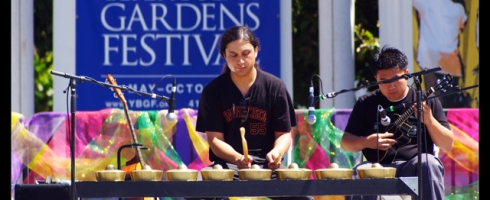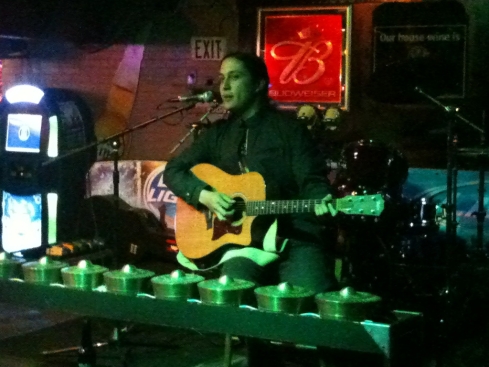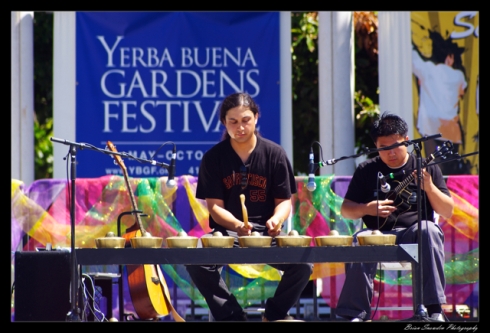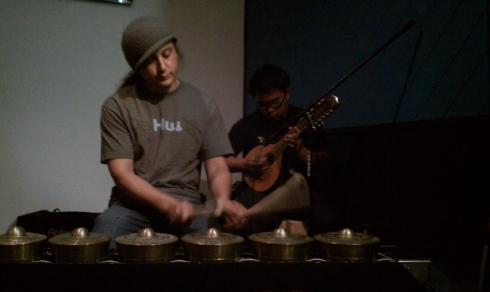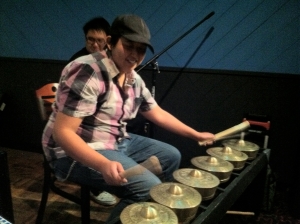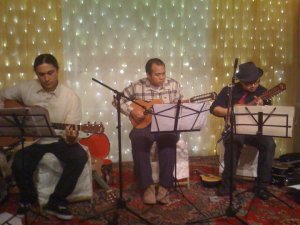
Performing Kulintang in the middle of Powell BART's Hallidie Plaza
A Filipino-American artist would love the San Francisco Bay Area. Today’s blog post is an account of how I spent my Sunday supporting Filipino events, crossing bridges, and taking pictures of gongs.

ACPA summons the dancers with music
The day began with a new Filipino Festival, the American Center of Philippine Arts‘ “Fall Festival” held in Oakland Chinatown at the Oakland Asian Cultural Center. This one is a little bit different than your summer-variety gathering, smartly held during the apex of the autumn season, indoors. Vendors set up behind tables instead of canvas picnic tents, and the audience could watch dance performances in the round with musicians playing from the stage.
This festival is a welcome addition for the East Bay Fil-Am community that does not have the luxuries that exist in San Francisco. San Francisco boasts four separate venues dedicated to the Fil-Am community, while East Bay Fil-Ams roam from venue to venue like sea nomads in an archipelago. Kudos to the Fall Festival organizers, let’s do it every Fall!
j
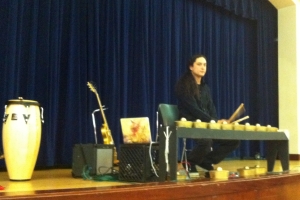
Kulintronica at ACPA's Fall Festival 2010
I was unable to watch the other dancers, performers, and speakers, or participate in the Pangalay Jam that occurred towards the finale. To keep up with the demand for Bay Area kulintang, I had to depart the festivities in Oakland and cross the Bay Bridge…
The Bay Area is itself somewhat like a collection of islands. Each neighborhood, separated by ridges, valleys, and water systems, has a different climate and community, tied together by freeways, buses, and the Bay Area Rapid Transit System (BART). The Powell BART station is a major downtown SF stop that takes you to the theater and shopping districts, and the South of Market neighborhood (SoMa), also known as the Filipino Social Heritage District, the site of our next adventure.
The Filipino community is deeply rooted in San Francisco, so when the city began a performing arts series at this heavy-traffic train station in the heart of downtown, it went to the premier presenter of contemporary and tribal Pilipino art, Kularts. I have so much gratitude for Kularts, who in a previous era, had its own brand of kulintang fusion brewing, and today provides me with inspiration, encouragement, and support.

James "Ganyan" Garcia skate jamming with Kulayan
Kularts presented Kulintronica with the Kulayan Arts Program, creating cutting edge visuals direct from the Filipino American imagination. Hanging out with these artists puts me in just the right mindset to pull Filipino traditions through the looking glass into the urban jungle.
The mixed crowd of commuters, shoppers, and homeless locals were all intrigued by what to them is a new and unusual instrument. Heads were turning, small crowds gathered, and the boldest walked right up to the kulintang stand and asked questions in the middle of a song. I welcome the interest and enjoy the wide eyes of music enthusiasts hearing a new sound. To my surprise, a visitor from Las Vegas sat down to play an impromptu Kaluntang with me after a few words of encouragement. I should have expected kulintang players to emerge out of the woodwork at a Kularts (formerly known as Kulintang Arts) sponsored event.
This double-header of kulintang gigs was a blessing in itself, but Fil-Am art is in abundance in the Bay Area, so despite having performed at two separate and successful Filipino events, it was time to go to event number three as a spectator.

Lendl San Jose with a gong electronic setup of his own
Over at the Bayanihan Community Center (one of the four SF Fil-Am spaces) was closing night for Aimee Suzara‘s “History of the Body” performed by the Pagbabalik Project. Three years ago I was musical director for this collective and produced the recorded theatrical soundtrack for Pagbabalik (Return) with Diskarte Namin musicians Juan Calaf and Jen Soriano.
Their current work, History of the Body, is in the capable hands of Lendl San Jose, pictured here playing a beautiful silver-tinged gangsa gong while triggering samples in the pit. His cello and ukulele are not pictured, but he played those too. History of the Body is a thought-provoking piece about body image and the legacy of colonization told in a non-linear style accentuated by world-class acting, dancing, and music. It stirred up emotional reactions from the audience and is a story that resonates beyond the Filipino community.
Thanks for tagging along with me on this re-telling of a typical Sunday in the San Francisco Bay Area, where Fil-Ams can either have their choice of Filipino event to attend, or commit to a marathon commute itinerary and try to see it all. I tried to see as much as I could, but even I was unable to do all of this and watch the Golda and the Guns/Julie Plugg show the night before.
Tags: ACPA, BART, Kularts, Kulayan, kulintang, Lendl, OACC, Oakland, Pagbabalik, SF

